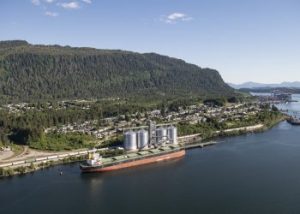
PRINCE RUPERT – The Prince Rupert Port Authority (PRPA) announced recently it has set another record for annual cargo volumes. Despite unprecedented challenges brought on by the pandemic, 32.4 million tonnes of cargo moved through the Port of Prince Rupert in 2020, nine percent more than in 2019.

Shaun Stevenson
“In a year marred by uncertainty, the Port of Prince Rupert has facilitated increased trade in support of Canada’s economic health through the pandemic enabling over $50 billion in international trade. Thanks to the diversification of our cargoes, and the commitment and determination to maintain a safe working environment through the pandemic by our Port partners and the men and women working in the gateway industry in northern British Columbia, the Port of Prince Rupert’s operations have remained resilient,” said Shaun Stevenson, President and CEO, Prince Rupert Port Authority. “Weathering the storms triggered by the Covid-19 pandemic, our Port has handily proven its resiliency, efficiency, and reliability as a key strategic trade gateway for Canada.”
Essential port operations provided important economic stability for the region in 2020. Port operations provided the foundation for $1.5 billion of economic activity, over 6,200 direct and indirect jobs related to moving trade through the northern BC corridor, and contributed nearly $12 million to local municipal government tax revenue.
The Port’s highest total volume to date was led by a rise in exports of coal, propane, and wood pellets. Ridley Terminal saw a year-over-year increase of 26 percent, driven by demand for thermal coal. AltaGas’ Ridley Island Propane Export Terminal marked its first full year of operation in May 2020 and ended the year with 1,159,207 tonnes loaded onto 27 vessels bound for Asia. Pinnacle Renewable Energy’s Westview Terminal had a record year, exporting 1,474,301 tonnes of wood pellets, an increase of 33 percent over 2019.
Factory shutdowns in Asia and locked down economies in North America caused a 19 percent drop in container traffic in the second quarter. However, volumes rebounded and DP World’s Fairview Container Terminal finished a mere six percent down with 1,141,390 TEUs moving through the Port for the year, attributed mostly to a decline in the volume of empty containers being shipped through Prince Rupert back to Asia.
While cargo volumes grew in 2020, passenger volumes dropped off significantly, with the cancellation of the summer cruise season and BC Ferries experiencing a steep decline in ridership. The Prince Rupert Port Authority continues to work closely with the cruise industry and local stakeholders to determine the best way to welcome back passengers when Transport Canada allows international travel and removes the no sail order, which restricts cruise vessels from calling on Canadian ports.
The obstacles presented by the pandemic have not hindered progress on several key projects aimed at sustainably growing and diversifying the Port complex. Construction crews are nearing completion of the Fairview-Ridley Connector Corridor, a 5-kilometre private haul road that will reroute container trucks away from city streets and signficantly reduce truck emissions; DP World gained regulatory approval for the southern expansion of Fairview Container Terminal that will support a future capacity of 1.8 million TEUs; Vopak Pacific Canada is expected to make a final investment decision on a new liquid bulk storage facility and marine berth on Ridley Island later this year; and the environmental assessment process began for the proposed Ridley Island Export Logistics Platform, a project that will support large-scale export transloading, maximizing value to Canadian exporters.
“We continue to advance the development of critical infrastructure and expansion projects that support the resilience of the gateway operations, and the growth and diversification of cargo handling capabilities and capacities at the Port Prince Rupert,” said Stevenson. “By expanding trade enabling infrastructure, we will not only support our local economy, but will be poised to offer Canadian industries a competitive edge as the global economy rebounds from the effects of the pandemic.”
To see the full cargo summary, click here.

